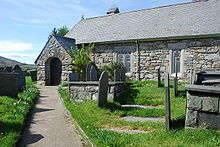Saint Materiana
Saint Materiana | |
|---|---|
 Banner of St Materiana in Minster Church | |
| Born | c. 440 Gwent, Wales |
| Died | early 6th century (?) Minster, Cornwall |
| Venerated in | Anglican Communion Catholic Church Eastern Orthodox Church[1] |
| Major shrine | Minster, Cornwall |
| Feast | 9 April |
| Attributes | crown; widow's robe |
| Patronage | Minster, Cornwall Tintagel, Cornwall Trawsfynydd, Wales |
Saint Materiana (also spelled Madrun, Madryn, Merteriana, Merthiana, and other variations) is a Welsh saint, patron of two churches in Cornwall and one in Wales.
Life
The name Materiana was corrupted to "Marcelliana" in medieval times. Another spelling of her name sometimes used is "Mertheriana" or "Merthiana", resembling the Welsh merthyr - "martyr". Matrona was a widespread Roman name, and there is no evidence of any purported connection with a pre-Christian goddess named Modron. Materiana is said to have been a princess of the 5th century, the eldest of three daughters of King Vortimer the Blessed,[2] who, after her father's death, ruled over Gwent with her husband Prince Ynyr.
Veneration
The Hymn to St Materiana in use at Tintagel calls her "Materiana, holy Mother" and prays her to "Over thy people still preside, over thy household, clothed in scarlet vesture of love and holy pride" and continues "Thy children rise and call thee blessed, gathered around thee at thy side." The 'Hymn to St Materiana' is not an ancient hymn, and of Anglican use.
Minster church

Materiana's primary patronal church is the parish church of Minster, dedicated under the name "Merteriana." The churches were established some time earlier than the settlement at Boscastle (in Norman times when a castle was built there). Until the Reformation, St Materiana's tomb was preserved in the church. Traditions of the saint were recorded by William Worcestre in 1478: he states that her tomb was venerated at Minster and that her feast day was 9 April.[3]
Tintagel church
The first church at Tintagel was probably in the 6th century, founded as a daughter church of Minster. By 1258, Materiana was recorded as Tintagel’s patroness by 1258.[4]
The current St Materiana's Church was restored by architect James Piers St Aubynin 1870. The north doorway dates to around 1080.[5] There are two memorials which portray St Materiana: a statue in the chancel and a stained glass window in the nave. The Cornish historian Charles Thomas proposed that the Norman church of Tintagel and its dedication to St Materiana were due to the patronage of William de Bottreaux, lord of Boscastle rather than the Earl of Cornwall.[6]
The parish feast traditionally celebrated at Tintagel was 19 October, the feast day of St Denys, patron of the chapel at Trevena.[7]
Trawsfynydd church

The parish church at Trawsfynydd is dedicated to a St Madryn, Princess of Gwent, who is usually identified with Materiana.[8]
See also
- Puerto Madryn—a town in Argentina named after Madryn, Nefyn, Wales
- Carn Fadrun—a hill in North Wales named after the saint
- Nefyn—a town in North Wales (the Madryn estate is nearby)
References
- ^ Hutchinson-Hall, John. Orthodox Saints of the British Isles. Vol II (St. Eadfrith Press, 2014) p. 38
- ^ Van der Kiste, John. The Little Book of Cornwall, The History Press, 2013 ISBN 9780752492698
- ^ Canner, A. C. (1982) The Parish of Tintagel. Camelford: A. C. Canner; pp. 32-33
- ^ "Tintagel, St Materiana", Cornwall Historic Churches Trust
- ^ "St Materiana, Tintagel restored by James Piers St. Aubyn", The Victorian Web
- ^ Thomas, Charles (1993) Tintagel, Arthur and Archaeology ISBN 0-7134-6690-1; pp. 19-20
- ^ Canner, A. C. (1982) The Parish of Tintagel. Camelford: A. C. Canner; p. 27
- ^ "EBK: St. Madrun". Earlybritishkingdoms.com. Retrieved 6 April 2020.
Further reading
- Canner, A. C. (1982) The Parish of Tintagel. Camelford: A. C. Canner; pp. 5–6, 94-95
External links
![]() Media related to Saint Materiana churches in the United Kingdom at Wikimedia Commons
Media related to Saint Materiana churches in the United Kingdom at Wikimedia Commons
